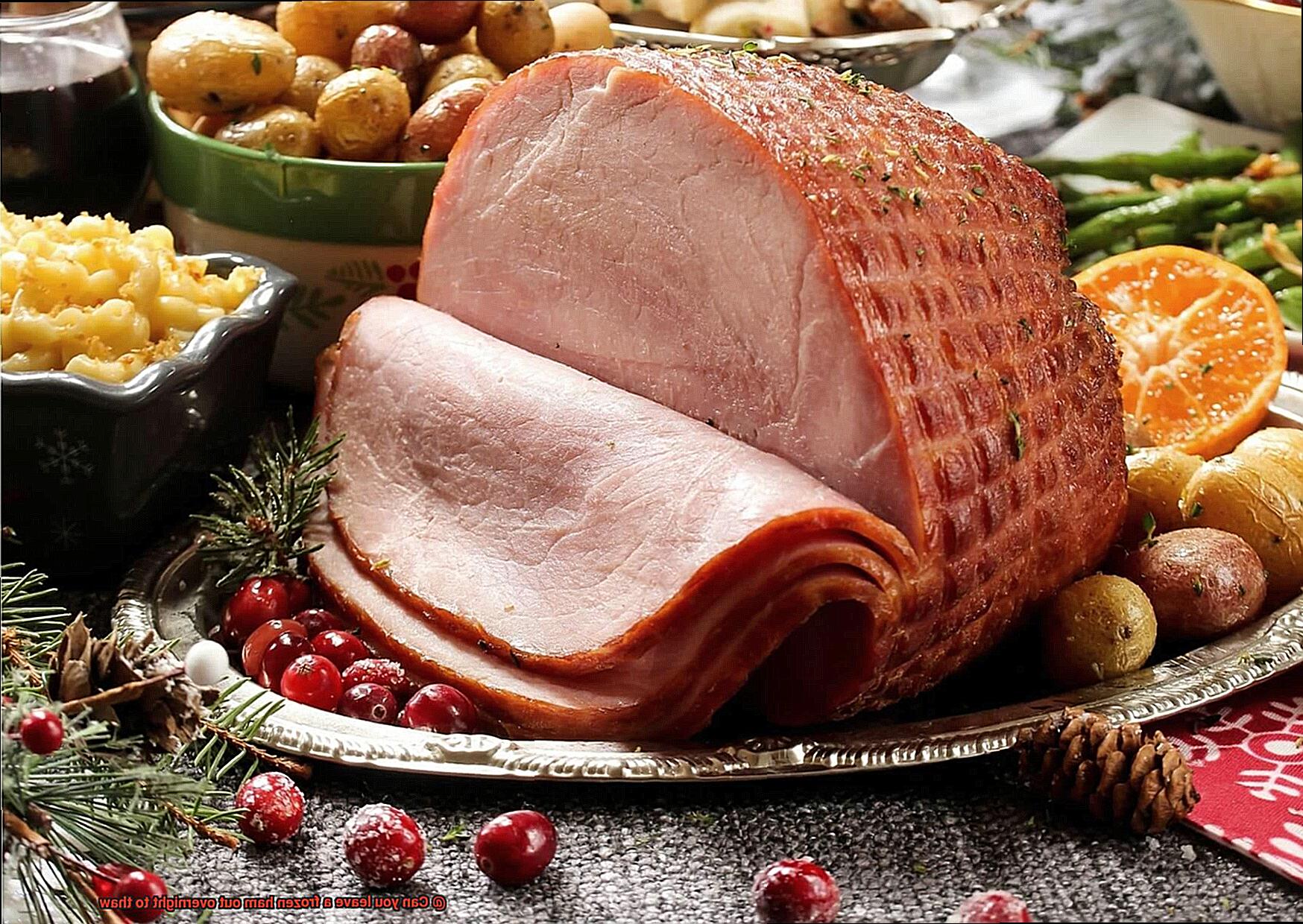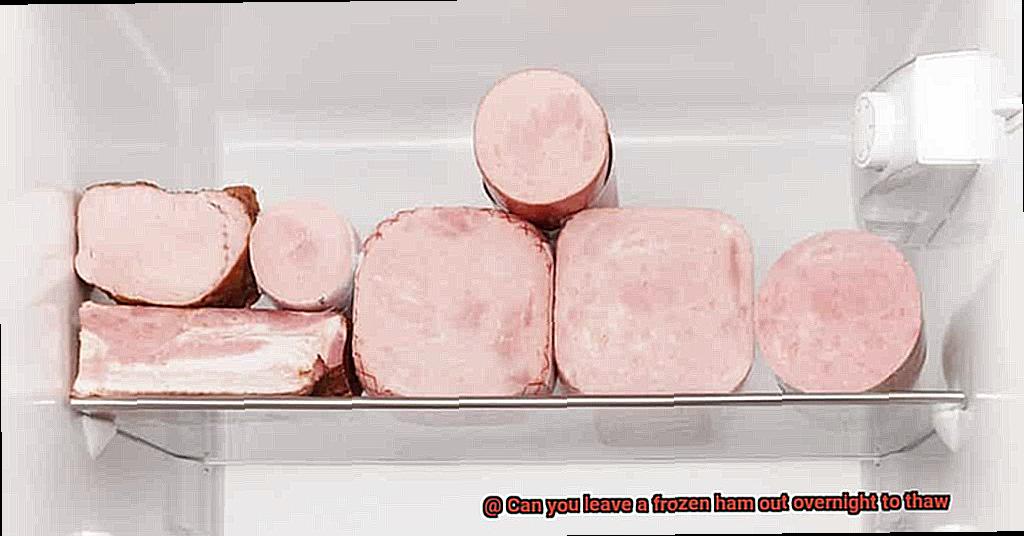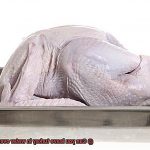The holiday season is upon us, and for many of us, that means one thing: ham time. Whether you’re cooking up a juicy honey-glazed spiral ham or a classic smoked version, it’s crucial to know how to thaw frozen ham safely. So, can you leave a frozen ham out overnight to thaw?
Imagine this scenario: It’s Christmas Eve, and you realize that you forgot to take the ham out of the freezer. You might be tempted to leave it out overnight to defrost in time for tomorrow’s feast. But hold on – before you do that, let’s talk about the potential dangers.
In this post, we’ll explore why leaving a frozen ham out at room temperature is a risky move. We’ll also look at some safer and quicker methods for thawing your holiday ham without sacrificing its delicious flavors.
First up, we’ll dive into the nitty-gritty of why leaving your ham out overnight can be hazardous to your health. Then we’ll discuss alternative ways to defrost your ham quickly and safely – think fridge, cold water bath, or microwave.
So if you’re eager to impress your guests with the perfect holiday ham, keep reading. We’ve got all the dos and don’ts of thawing frozen ham covered.
Contents
What Happens If You Leave a Frozen Ham Out Overnight to Thaw?
You may want to think twice before doing it again. It can have serious consequences that are not only dangerous but also affect the taste and texture of your meat.
When meat is left at room temperature for a prolonged period, it creates a perfect breeding ground for harmful bacteria to thrive and multiply rapidly. Salmonella, E.coli, and Listeria are just a few examples of bacteria that can grow on the surface of thawing meat and cause severe food poisoning if consumed. Symptoms include vomiting, diarrhea, fever, and abdominal pain. In severe cases, food poisoning can result in hospitalization and even death.
But the risks don’t end there. The outer layers of the frozen ham will start to defrost while the inside remains frozen. This creates an environment where the outer layers are exposed to warm temperatures, making it an ideal breeding ground for bacteria. The longer the ham stays at room temperature, the greater the chances are that harmful bacteria will grow.
Moreover, leaving a frozen ham out overnight can also affect the taste and texture of the meat. As the outer layers defrost and are exposed to warm temperatures, they can spoil and develop off-flavors. Additionally, if not properly wrapped or stored during thawing, it can become dry and tough.
So what should you do instead? The USDA recommends three safe methods for thawing meat: in the refrigerator, in cold water, or in the microwave. Thawing in the refrigerator is the safest method as it allows enough time for the ham to thaw completely without any risk of bacterial growth. This process may take several hours or even a few days depending on the size of your ham.
If you need to thaw your ham quickly, you can use the cold water method. Place your frozen ham in a leak-proof plastic bag and submerge it in cold water. Change the water every 30 minutes until the ham is completely thawed. This method should take no more than a few hours, depending on the size of your ham.
Recommended Methods for Thawing a Frozen Ham

Thawing a frozen ham can be a daunting task, but it’s essential to thaw it safely to avoid the risk of food poisoning. As an expert in recommended methods for thawing a frozen ham, I have compiled some useful tips and tricks to make sure your meat stays safe to eat while preserving its taste and texture.
The refrigerator method is the safest way to thaw a frozen ham. It involves placing the ham in a container or on a plate and putting it in the refrigerator to thaw slowly over a period of 24-48 hours. This method is ideal if you have ample time before you plan to cook the ham. Make sure to place the ham on the lowest shelf of the refrigerator to avoid any cross-contamination with other foods.
If you’re short on time, you can use the cold water method to thaw your frozen ham. This method involves placing the ham in a leak-proof bag and submerging it in cold water. You will need to change the water every 30 minutes to ensure that it stays cold and continues to thaw the ham. This method is faster than using the refrigerator but requires more monitoring.
While using a microwave is also an option for thawing a frozen ham, this method requires caution as microwaves can cook parts of the meat if not done correctly. To use this method, place the ham on a microwave-safe dish and defrost it using the ‘defrost’ setting on your microwave. Be sure to rotate the ham every few minutes and check for any cooked spots.
It’s crucial to remember that using hot water or leaving the frozen ham out at room temperature are not recommended as they can cause bacterial growth and increase the risk of food poisoning. Meat should never be left out at room temperature for more than two hours.
Thawing in the Refrigerator
If you’re planning to cook a succulent ham for your next family gathering or holiday feast, it is crucial to ensure that the meat is safely thawed before cooking. While there are many ways to defrost a frozen ham, thawing in the refrigerator is the safest and most recommended method. As an expert, I have compiled the following research notes to help guide you through the process of thawing a frozen ham in the refrigerator.
Firstly, it’s important to note that thawing a frozen ham in the refrigerator is a gradual process that requires careful planning and patience. For every five pounds of ham, it can take up to 24 hours to fully thaw. Therefore, it’s essential to plan accordingly and allow enough time for the ham to defrost completely before cooking.
To begin, remove the frozen ham from the freezer and place it on a plate or tray to catch any juices that may leak. Then, place the ham in the refrigerator on the bottom shelf where it can remain undisturbed until fully thawed. Make sure to keep the ham in its original packaging or wrap it tightly with aluminum foil or plastic wrap to prevent any contamination from other food items.
While thawing in the refrigerator may take longer than other methods, it’s the safest way to thaw a frozen ham. By keeping the ham at a temperature below 40°F (4°C), this prevents bacterial growth and ensures that your food remains safe for consumption.
Here are some additional tips to ensure that your ham defrosts correctly:
- Keep an eye on the temperature of your refrigerator and make sure it stays below 40°F (4°C)
- If you’re short on time, consider using a microwave or cold water bath for quicker defrosting
- Once your ham is fully thawed, cook it immediately or store it in the refrigerator for up to four days
The Cold Water Method
As a culinary expert, I am here to share with you the cold water method that will thaw your ham quickly and safely.
The cold water method is a simple yet effective process that involves placing your frozen ham in a leak-proof plastic bag and submerging it in cold water. By keeping the ham in cold water, you prevent harmful bacteria growth while allowing the meat to defrost at a reasonable pace.
However, it’s essential to note that the time required for thawing depends on the size of your ham. A small ham may take around 2-3 hours to thaw, while a larger one may take up to 12 hours or more. Therefore, it’s crucial to plan ahead and allow enough time for your ham to defrost properly.
One important aspect of using the cold water method is changing the water every 30 minutes. This step is crucial because stagnant water can become too warm and create an environment for bacterial growth. By changing the water regularly, you keep the temperature low and ensure that your ham stays safe to eat.
It’s also vital to ensure that your ham is fully thawed before cooking it. Cooking a partially frozen ham can lead to uneven cooking and potential health risks. To test if your ham is ready, gently press on the meat with your fingers. If it feels soft and pliable, then it’s ready to be cooked and enjoyed.
The Microwave Method
The microwave method is a popular solution, but it requires caution. Before you begin, take note of a few important details.
First, remove the ham from its packaging and place it in a microwave-safe dish. Next, set your microwave to the defrost setting and enter the weight of the ham. The microwave will automatically determine the defrost time based on the weight.
However, uneven thawing can be a concern with this method, leading to potential food safety issues. To prevent this, monitor your ham closely as it thaws in the microwave. Rotate it every few minutes to ensure even thawing.
Once your ham is fully thawed, it’s essential to either cook it immediately or store it in the fridge if you’re not ready to prepare it yet. Additionally, if your ham weighs more than four pounds, another thawing method is recommended.
So, what are the benefits of using the microwave method? It’s a quick and easy way to thaw frozen ham without needing to plan ahead. However, it’s vital to use this method carefully and correctly to avoid any health risks.
Is Leaving a Frozen Ham Out Overnight to Thaw Safe?
Before you start planning your menu, let’s ensure you know the proper way to thaw your frozen ham. It may be tempting to opt for the easy route of leaving your ham out overnight to thaw but, unfortunately, this method is not safe.
Leaving any frozen meat out at room temperature for too long can create a breeding ground for bacteria growth. These bacteria can cause foodborne illnesses such as salmonella or E. coli. So, what is the best and safest way to thaw your ham?
The United States Department of Agriculture (USDA) recommends that the safest way to thaw a frozen ham is in the refrigerator. This method may take a bit longer, but it allows for a gradual thaw that keeps your meat at a safe temperature and prevents bacterial growth. For every 4-5 pounds of ham, it will take approximately 24 hours to thaw in the fridge. So, plan ahead and give yourself plenty of time.
If you’re short on time and need a speedy thawing process, you can use the cold water method. This involves placing your frozen ham in a leak-proof plastic bag and submerging it in cold water. Remember to change the water every 30 minutes until your ham is fully thawed. Although this method is faster than using the fridge, it requires more attention and effort.
What Are the Risks of Leaving a Frozen Ham Out Overnight to Thaw?
Think twice before taking the easy way out. While it may seem like a convenient option, there are some serious health risks associated with leaving a frozen ham out overnight to thaw.
One of the main dangers of leaving a ham out overnight is the potential for bacterial growth. When food is left at room temperature for an extended period, harmful bacteria can grow and multiply rapidly. As the ham thaws, its surface temperature rises into the danger zone of 40°F to 140°F, which is an ideal temperature range for bacterial growth. Any bacteria present on the surface of the ham can multiply to dangerous levels, causing illness when consumed.
But that’s not all. Another risk associated with leaving a frozen ham out overnight to thaw is uneven thawing. Thawing meat at room temperature can be unpredictable, with some parts of the meat thawing faster than others. This can result in uneven cooking and potentially dangerous undercooked portions.
And let’s not forget about the risk of dry, unappetizing meat. Leaving a frozen ham out overnight to thaw can cause it to lose moisture, affecting both the texture and taste of the meat.
So, what’s the solution? To minimize these risks, it’s recommended to thaw your frozen ham in the refrigerator or in cold water, changing the water every 30 minutes. While these methods may take longer than leaving it out at room temperature, they are much safer and will result in a more evenly thawed and better-tasting ham.
To ensure food safety, remember these tips:
- Never leave any food at room temperature for more than two hours.
- Always thaw frozen foods in the refrigerator or in cold water.
- Use a food thermometer to check that your ham has reached a safe internal temperature of 145°F before serving.
Tips for Safely Thawing a Frozen Ham
Thawing a frozen ham is a crucial step in preparing it for cooking, but it’s essential to do so safely to avoid any risk of foodborne illness. Here are five tips for safely thawing a frozen ham:
Plan Ahead
Thawing a frozen ham can be time-consuming, and it’s crucial to plan ahead. Allow 24 hours of thawing time for every 5 pounds of ham. For instance, if you’re thawing a 10-pound ham, you should plan on thawing it in the refrigerator for at least two full days before cooking. Proper planning can ensure that your ham is safe and delicious to eat.
Use the Refrigerator
The safest way to thaw a frozen ham is by using the refrigerator. Place the ham on a tray or dish and let it thaw in the refrigerator for 24 hours per 5 pounds of meat. This slow thawing process ensures that the ham remains at a safe temperature range of 40°F or below, which inhibits bacterial growth. Thawing in the refrigerator also helps to maintain the quality and texture of the meat.
Cold Water Method
If you’re short on time, you can use the cold water method to thaw your ham. Submerge the frozen ham in cold water, changing the water every 30 minutes until it’s thawed. This method is faster than thawing in the refrigerator but requires more attention and effort. You need to be sure to keep the ham at a safe temperature of 40°F or below throughout the thawing process.
Monitor Water Temperature
When using the cold water method, it’s essential to monitor the water temperature regularly to ensure that it stays cold throughout the thawing process. You can use a thermometer to check the water temperature regularly and add ice if needed.
Never Leave Ham at Room Temperature
It’s never safe to leave a frozen ham out overnight to thaw at room temperature. Bacteria can multiply rapidly when meat is left at room temperature, increasing the risk of foodborne illness. Additionally, leaving a frozen ham out overnight can cause the outer layer of the meat to become soft and mushy, affecting its texture and flavor.
mjY3sCs1Fec” >
Conclusion
In conclusion, leaving a frozen ham out overnight to thaw is a risky move that can lead to bacterial growth and compromise the taste and texture of the meat. Fortunately, there are three safe methods for thawing a frozen ham: in the refrigerator, in cold water, or in the microwave.
The refrigerator method is the safest because it allows ample time for the ham to thaw without any risk of harmful bacteria. If you’re short on time, you can use either the cold water or microwave method, but it’s essential to follow proper procedures and monitor them closely.
Remember that food safety should always be a top priority when preparing holiday meals. Don’t take any chances with your guests’ health; plan ahead and allow enough time for proper thawing using one of the recommended methods.
With these tips from culinary experts, you can confidently prepare a mouth-watering holiday ham that will impress your guests while keeping them safe from potential health hazards.






